engine AUDI S6 2009 Owners Manual
[x] Cancel search | Manufacturer: AUDI, Model Year: 2009, Model line: S6, Model: AUDI S6 2009Pages: 398, PDF Size: 43 MB
Page 315 of 398
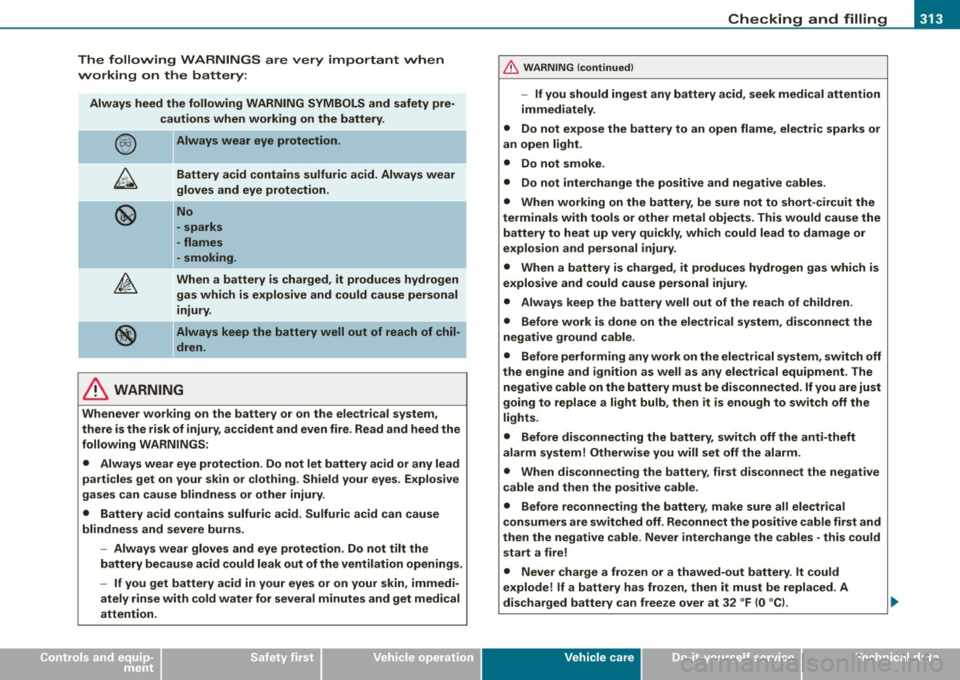
__________________________________________ C_ h _ e_c _k _in _ g =- a_ n __ df _i_ lli _n ___ g __ fflllll
•
The following WARNINGS are very important when
working on the battery:
Always heed the following WARNING SYMBOLS and safety pre
cautions when working on the battery .
Always wear eye protection.
Battery acid contains sulfuric acid. Always wear
gloves and eye protection.
No
- sparks
- flames
- smoking.
When a battery is charged, it produces hydrogen
gas which is explosive and could cause personal
injury.
Always keep the battery well out of reach of chil
dren.
& WARNING
Whenever working on the battery or on the electrical system,
there is the risk of injury, accident and even fire. Read and heed the
following WARNINGS:
• Always wear eye protection. Do not let battery acid or any lead
particles get on your skin or clothing. Shield your eyes. Explosive
gases can cause blindness or other injury.
• Battery acid contains sulfuric acid. Sulfuric acid can cause
blindness and severe burns.
- Always wear gloves and eye protection. Do not tilt the
battery because acid could leak out of the ventilation openings.
- If you get battery acid in your eyes or on your skin, immedi
ately rinse with cold water for several minutes and get medical
attention.
& WARNING (continued)
-If you should ingest any battery acid, seek medical attention
immediately.
• Do not expose the battery to an open flame, electric sparks or
an open light.
• Do not smoke.
• Do not interchange the positive and negative cables .
• When working on the battery, be sure not to short -circuit the
terminals with tools or other metal objects. This would cause the battery to heat up very quickly, which could lead to damage or
explosion and personal injury.
• When a battery is charged, it produces hydrogen gas which is
explosive and could cause personal injury.
• Always keep the battery well out of the reach of children.
• Before work is done on the electrical system, disconnect the
negative ground cable.
• Before performing any work on the electrical system, switch off
the engine and ignition as well as any electrical equipment. The
negative cable on the battery must be disconnected.
If you are just
going to replace a light bulb, then it is enough to switch off the
lights.
• Before disconnecting the battery, switch off the anti-theft
alarm system! Otherwise you will set off the alarm.
• When disconnecting the battery, first disconnect the negative
cable and then the positive cable.
• Before reconnecting the battery, make sure all electrical
consumers are switched off. Reconnect the positive cable first and
then the negative cable . Never interchange the cables - this could
start a fire!
• Never charge a frozen or a thawed-out battery. It could
explode! If a battery has frozen, then it must be replaced. A
discharged battery can freeze over at 32 °F (0 °CI. .,,_
Vehicle care
I t •
Page 316 of 398

llffl __ C _h_ e_ c_k _in --== g'-- a_n _d_ f_il _li _n ..:::g:::..- ___________________________________________ _
& WARNING (continued)
• Make sure the vent hose is always attached to the opening on
the side of the battery.
• Never use batteries which are damaged . There is the danger of
an explosion! Always replace a damaged battery.
& WARNING
California Proposition 65 Warning :
• Battery posts, terminals and related accessories contain lead
and lead compounds, chemicals known to the State of California
to cause cancer and reproductive problems. Wash hands after
handling .
0 Note
• Do not disconnect the vehicle battery when the ignition is
switched on or when the engine is running, otherwise, you will
damage electronic components in the electrical system .
• If your vehicle is going to stand for a long period of time without
being driven, protect the battery from "freezing", otherwise it will
be damaged and will then have to be replaced. •
Battery charging
Starting the engine requires a well charged battery.
Fig. 245 Engine
compartment : Connec
tors for charger and
jumper cables
Always read and heed all WARNINGS below=> & and=> &
in "Working on the battery" on page 312.
- Turn off the ignition and all electrical consumers.
- Make sure the area is well ventilated when you charge
the battery.
- Open the hood => page
300.
-Open the red cover on the positive pole=> fig. 245.
- Connect the charger connectors according to the instruc-
tions to the
jump start bolts. (Bolts under the red cover=
" posit ive", Bolts with hex head= "negative").
- Only now plug the mains lead for the charging equip
ment into the wall outlet and turn it on =>& .
-Make sure the charging rate is not over 30 amps/14.8
Volt.
- When the battery is fully charged: Turn the charging
equipment off and remove the mains lead from the wall
outlet. .,_
Page 317 of 398

Checkin g and fillin g -
--------------~-
•
-Now remove the clamps fo r the charging eq uipment.
- Close t he red cover on the positive pole.
- Close the hood~
page 301.
A discharged battery can freeze at temperatures of only O °C. A llow
a frozen battery to thaw completely before attempting to charge it
~ & .However, we recommend not using a thawed battery again
because the battery casing can be cracked due to ice formation and
can leak battery acid.
Batt ery c harg ing (Ma ximum ch arging rate of 30
a mps /14 .8 Volt )
When charging at /ow voltages (e.g. with a trickle charg er), the
ba ttery cables do not have to be disconnected first. The battery caps
should
not be opened when charging a battery.
I t is not necessary to remove the battery from the luggage compart
ment .
Fa st cha rging the batt ery (chargi ng ra te ab ove 14 .8
Volt s)
For technical reasons do not use a battery charger that uses vo ltage
greater than 14.8 Volts to charge your vehic le's battery.
& WARNING
C harging a battery can be d angerou s.
• Alwa ys follo w the oper ating instruct ions pro vided b y the
battery charger manuf acturer when charging your b attery .
• Neve r charge a frozen battery. It m ay explode be cau se of gas
tr apped in the i ce. Allow a frozen battery to thaw out fir st.
• Do not reuse batteries wh ich were fro zen. The battery housing
m ay hav e crac ked and wea kened when the b atte ry fro ze .
• Charge the battery in a well ventilated area. Keep away from
open fla me or ele ctri cal s par k. Do not smok e. Hydrogen ga s gener
ated by the battery is explo sive.
&_ W ARN ING (c ontinued )
• To redu ce the danger of explo sion, never connect or d isconnect
c h ar ger cable s while the charger is ope rat ing .
• Batte ry acid that may spill durin g charging should be w ashed
off with a sol ution of warm water and b aking soda to neutralize
the acid .
0 Note
Never use a fast charger as a booster to start the engine . This wi ll
seriously damage sensitive electronic components, such as control
units, re lays, radio, etc ., as well as the battery charger. •
Battery replacement
The new battery must have the same specifications and
dimensions as the original equipment battery.
Intelligent energy management in your vehicle is responsib le for
distributing the e lectrica l energy throughout your vehicle
~ page 269 . The intelligent energy management system will keep
the engine battery charged better then vehicles without this system.
To make sure the additional electrical energy is availab le once again
after you have changed the battery, we recommend that you insta ll
batteries of the same type and manufacture only (the same as those
insta lled at the t ime your vehicle was de livered). Specif ications are
listed on the battery housing . Your authorized Audi dealer wi ll then
code the battery management con trol unit.
I f it is not possib le to use a battery of this type, the new battery must
have the same capacity, voltage (12 volts), amperage, construction
and p lug sealing .
When installing the battery, make sure the ignition and all electrical consumers are tur ned off.
~
Vehicle care I t •
Page 318 of 398
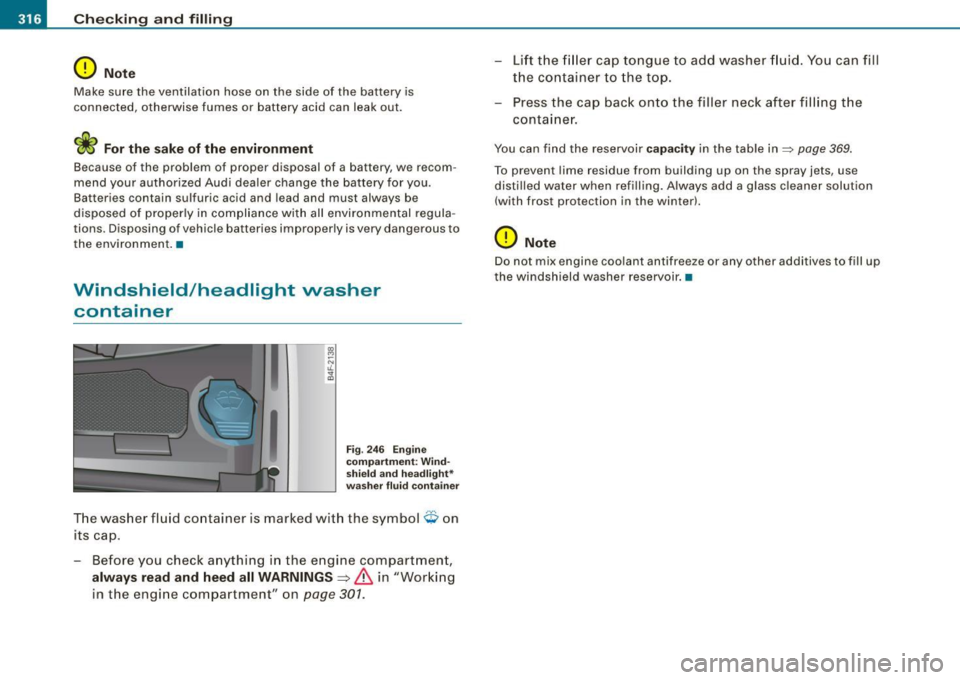
___ C_h_ e_ c_k _in --=:: g;__ a_n _d_ f_il _li _n ..:g:a.- ___________________________________________ _
0 Note
Make sure the ventilation hose on the side of the battery is
connected, otherwise fumes or battery acid can leak out.
mend your authorized Audi dea ler change the battery for you.
Batteries contain sulfuric acid and lead and must always be
disposed of properly in compliance with all environmental regula
tions . Disposing of vehicle batteries improperly is very dangerous to
t he environment. •
Windshield/headlight washer
container
Fig . 246 Engine
compartment: Wind
s hie ld and headlight*
washer fluid container
The washer fluid container is marked with the symbol O on
its cap.
- Before you check anything in the engine compartment,
always read and heed all WARNINGS :::> & in "Working
in the engine compartment" on page
301 .
-Lift the fille r cap tongue to add washer fluid. You can fill
the container to the top.
- Press the cap back onto the filler neck after filling the
container.
You can find the reservoir capacity in the table in=> page 369.
To prevent lime residue from building up on the spray jets, use
distilled water when refilling. Always add a gla ss cleaner solution
(with frost protection in the winter).
0 Note
Do not mix engine coolant antifreeze or any other additives to fill up
the windshield washer reservoir.•
Page 324 of 398
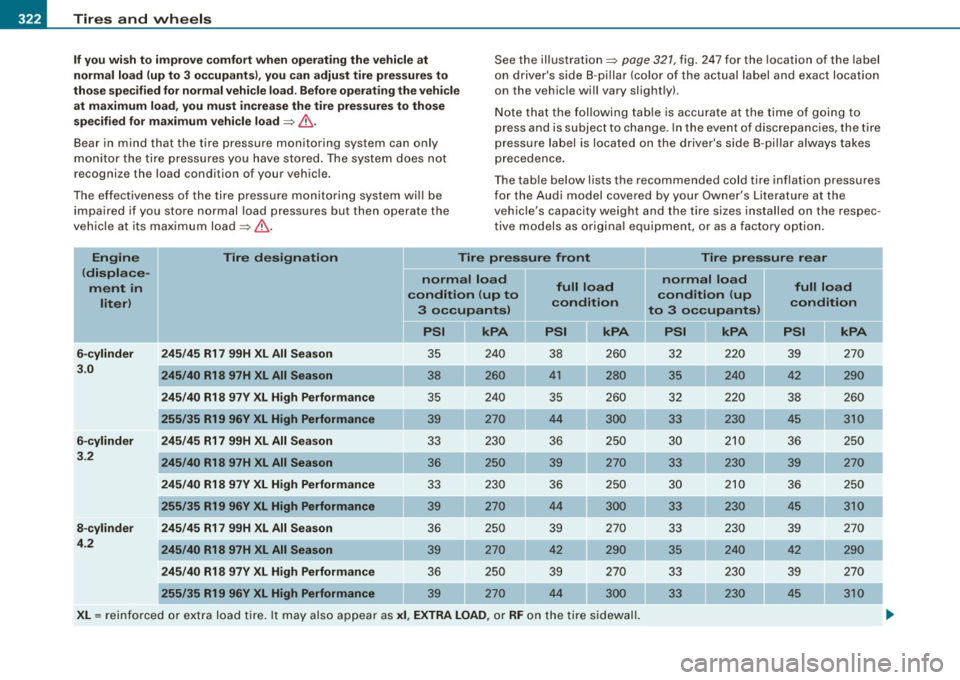
-Tires and wheels
PW-------------------
If you wish to improve comfo rt when operating the vehicle at
normal load (up to 3 occupants) , you can adjust tire pressures to
those spec ified for normal vehi cle load . Before operating the vehi cle
at maximum load, you must in crease the tire pressures to those
specified for ma ximum vehi cle load =>
&.
Bear in mind that the tire pressure monitoring system can on ly
m onito r the t ire pressures you have stored. The syste m does not
recognize the load condition of your vehic le .
The effect iveness of the tir e pr essure moni toring syste m will be
impaired if you store normal load pressures but then operate the
veh ic le a t its ma ximum load=>& . See the
illustrat ion=>
page 321, fig. 247 for the location of the label
on driver's sid e 8-pi llar (c olor of the actual label and exac t loca tion
on the veh ic le wi ll vary slight ly) .
N ote that the fol lowing tab le is accurate at the time of going to
press and is subject to cha nge . In the eve nt of d iscrepa nc ies, t he tire
pressure label is located on the driver's side 8 -pi llar always takes
p recedence .
T he tab le below lists the recommended cold tire inflation pressures
fo r th e A udi m odel co ve red by you r Owner 's Litera ture at the
vehic le's capacity weight and the tire sizes installed on the respec
t ive mode ls as o rigi nal equipment, o r as a fac to ry o ption.
Engine Tire designation Tire pressure front Tire pressure rear
(displace- normal load normal load
ment in condition (up to full load
condition (up full load
liter ) condition
condition
3 occupants) to 3 occupants)
PSI kPA
PSI kPA
PSI kPA PSI
kPA
6-cylinder
245/45 R17 99H XL All Season 35 240 38 260 32 220 39 270
3 .0
245/40 R18 97H XL All Season 38 41 280 35 240 290
245 /40 R18 97V XL High Performance
35 240
35 260 32 220 38 2 60
255 /35 R19 96V XL High Performance 39 270 44 300 33 230 45 3 10
6 -cylinder 245 /45 R17 99H XL All Season 33 230 36 250 3 0 210 36 250
3 .2
245/40 R18 97H XL All Season
36 250 39 270 33 230 39 270
245 /40 R18 97V XL High Performance 33 230 36 250 3 0 21 0 36 250
255 /35 R19 96V XL High Performance 39 270 44 300 33 230 45 310
8 -cylinder 245 /45 R17 99H XL All Season
36 250 39 270
33 230 39 270
4 .2
245/40 R18 97H XL All Season 39 270 42 290 35 2 40 42 2 90
245 /40 R18 97V XL High Performance 36 250 39 270 33 230 39 270
255 /35 R19 96V XL High Performan ce
39 270
44 300 33 230 45 310
XL= reinforce d or ex tra load tire . It may als o ap pear as xi, EXTRA LOAD, or RF o n the tire s ide wall.
Page 345 of 398
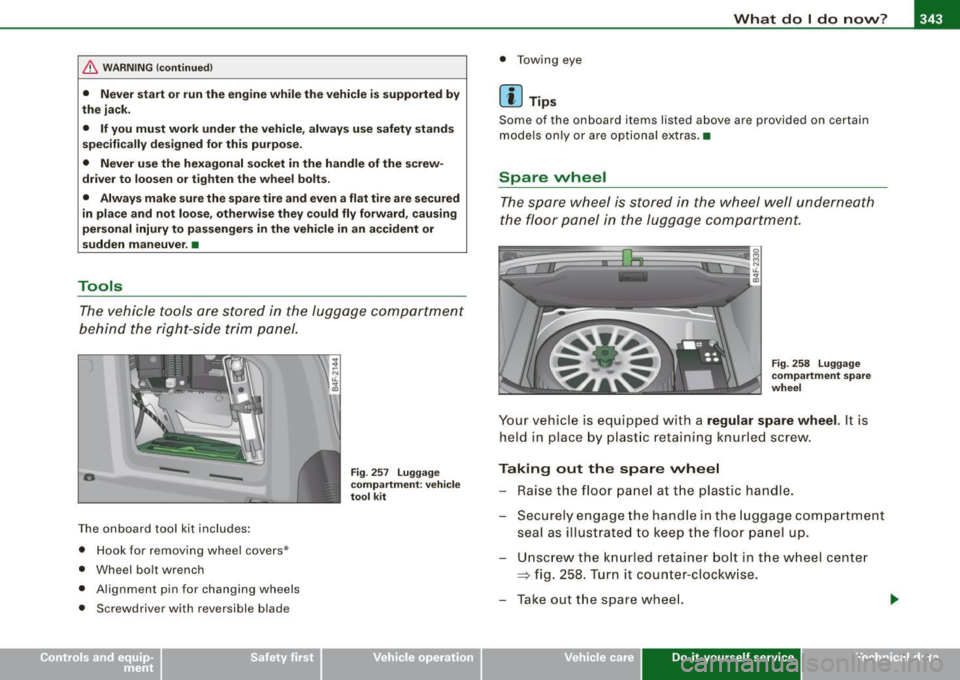
What do I do now? 111111 _______________________________ ....:..:..:..:..:.:..:--=.:..::....:.....:.:...::..___;__ _ __,J
& WARNING !continued)
• Never start or run the engine while the vehicle is supported by
the jack.
• If you must work under the vehicle, always use safety stands
specifically designed for this purpose.
• Never use the hexagonal socket in the handle of the screw
driver to loosen or tighten the wheel bolts.
• Always make sure the spare tire and even a flat tire are secured
in place and not loose, otherwise they could fly forward, causing
personal injury to passengers in the vehicle in an accident or
sudden maneuver. •
Tools
The vehicle tools are stored in the luggage compartment
behind the right-side trim panel.
-
-
The onboard tool kit includes:
• Hook for removing wheel covers *
• Wheel bolt wrench
• Alignment pin for changing wheels
• Screwdriver with reversible blade
Fig. 257 Luggage
compartment: vehicle
tool kit
• Towing eye
[ i] Tips
Some of the on board items listed above are provided on certain
models only or are optional extras.•
Spare wheel
The spare wheel is stored in the wheel well underneath
the floor panel in the luggage compartment.
Fig. 258 Luggage
compartment spare
wheel
Your vehicle is equipped with a regular spare wheel. It is
held in place by plastic retaining knurled screw.
Taking out the spare wheel
- Raise the floor panel at the plastic handle.
- Securely engage the handle in the luggage compartment
seal as illustrated to keep the floor panel up.
Unscrew the knurled retainer bolt in the wheel center
=> fig. 258. Turn it counter-clockwise.
- Take out the spare wheel.
Vehicle care Do-it-yourself service irechnical data
Page 346 of 398
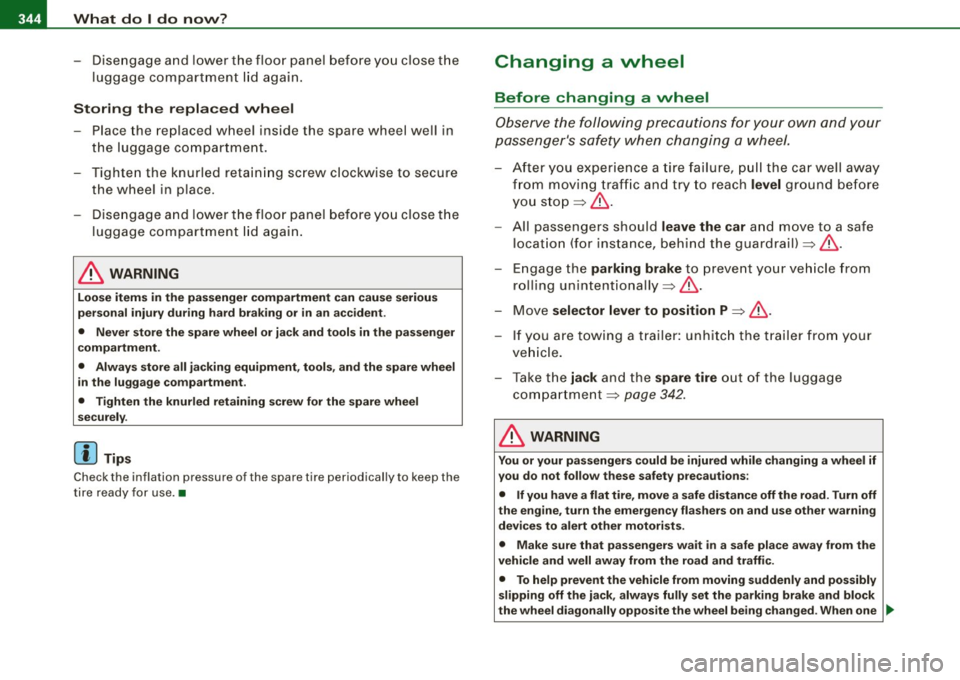
1111!1.___W_ h_ a_ t_ d_o_ l_ d_ o _ n_ o_w _ ? ____________________________________________ _
- Disengage and lower the floor panel before you close the
luggage compartment lid again.
Storing the replaced wheel
- Place the replaced wheel inside the spare wheel well in
the luggage compartment .
Tighten the knurled retaining screw clockwise to secure the wheel in place.
- Disengage and lower the floor panel before you close the
luggage compartment lid again.
& WARNING
Loose items in the passenger compartment can cause serious
personal injury during hard braking or in an accident .
• Never store the spare wheel or jack and tools in the passenger
compartment.
• Always store all jacking equipment, tools, and the spare wheel
in the luggage compartment.
• Tighten the knurled retaining screw for the spare wheel
securely.
[ i] Tips
Check the inflation pressure of the spare tire periodically to keep the
tire ready for use. •
Changing a wheel
Before changing a wheel
Observe the following precautions for your own and your
passenger's safety when changing a wheel.
- After you experience a tire failure, pull the car well away
from moving traffic and try to reach level ground before
you stop :::;. & .
- All passengers should leave the car and move to a safe
location (for instance, behind the guardrail) :::;,& .
- Engage the parking brake to prevent your vehicle from
rol ling unintentionally :::;.& .
- Move selector lever to position P :::;. & .
-If you are towing a trailer: unhitch the trailer from your
vehicle.
- Take the jack and the spare tire out of the luggage
compartment:::;.
page 342.
& WARNING
You or your passengers could be injured while changing a wheel if
you do not follow these safety precautions:
• If you have a flat tire, move a safe distance off the road. Turn off
the engine, turn the emergency flashers on and use other warning
devices to alert other motorists.
• Make sure that passengers wait
in a safe place away from the
vehicle and well away from the road and traffic.
• To help prevent the vehicle from moving suddenly and possibly
slipping off the jack, always fully set the parking brake and block
the wheel diagonally opposite the wheel being changed. When one ...
Page 354 of 398

-Fuses and bulbs Pffl..._ _____________________ _
[ i J Tip s
You are wel l advised to keep a supply of spare fuses in your vehicle .
Fuses with the proper ampere ratings are availab le at your Audi
dea ler. •
Fuse Location , Instrument Panel left
Fig . 267 Fuse pa nel
l ayo ut
Some of the equipment items listed are optional or only ava ilable on
certain model configurations .
Note th at t he fo llo wi ng t able i s acc urat e at th e time of goin g to
pr ess and is subject t o ch ang e. In th e eve nt of d iscrep ancie s, th e
labe l on th e in side of th e cover always ta kes prece de nce .
The power seats are protected by cir cuit br eaker s, which automati
cally reset after a few seconds after the overload has been reme
died.
N o. Equipm ent
1 Not used
2
3
4
Not used
Engine management
Oil level sensor Amps
5
5
No
.
5
6
..
7
8
9
10
1 1
12
13
14
15
16
17
18
19
20
21
22
23
24
25
26
27
28
Equipm ent
Climate cont rol , tire pressure monitoring sys
tem
Electronic Stabilization Program (ESP), clutch
sensor
Diagnostic connector
Homelink control unit
Automa tic dimming interior mirror
Adaptive Cruise Control
Not used
Diagnostic connector
Switch modu le steering column
Not used
I nstrument c luster, control module Ga teway
Telephone, cell phone E lectronic Stabilization Program (ESP)
Headlight electronics, left -side
Rain sensor
Heated washer nozzles
Seat adjustment (driver)
MMI display
E lectromechanica l parking brake
Not used
Not used
Not used
N ot used
Not used Amps
5
5
5
5
5
5
10
10
10
5
10
5
5
5
10
5
5
-
Page 355 of 398
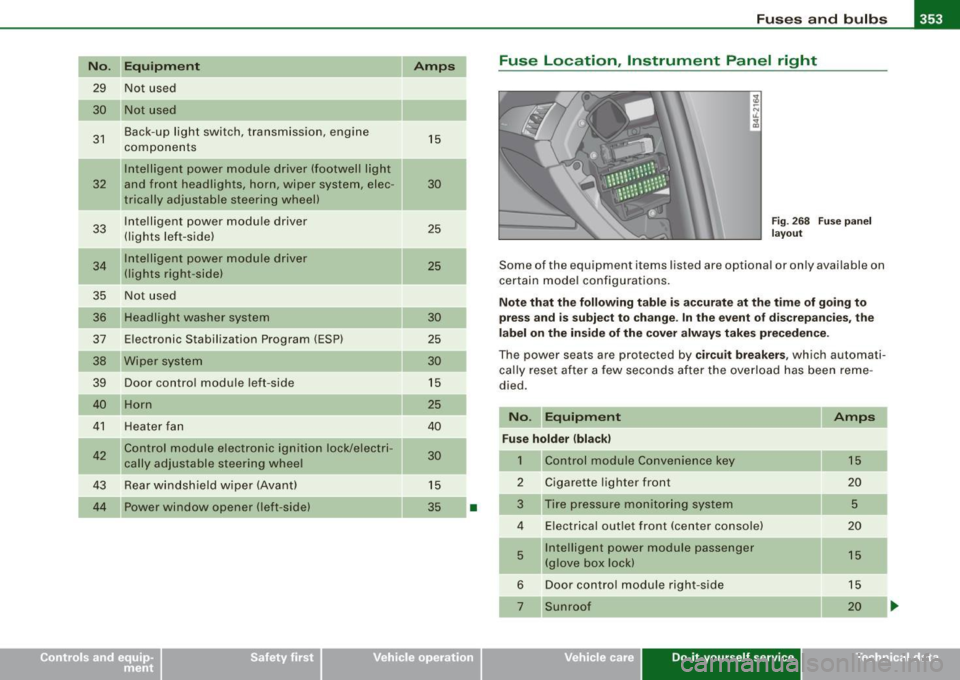
Fuses and bul bs -_____________ -----=----.;....:..::.:....:.::;______J
No. Equipm ent
29 Not used
30 Not used
31 Back-up light switch, transmission, engine
components
Intelligent power mo dule driver (footwell l ight
32 and front headlights, horn, wiper system, elec
trically adjusta ble steering wheel)
33 Intelligent power modu le driver
(lights left-side)
---,--
34
35
36
37
38
39
I nte lligent power module driver
(lights right-side)
Not used
Headlight washer system
E lectronic Stabilization Program (ESP)
Wip er system
Door control module left -side
Horn
41 Heater fan
42 Control module electronic ignition lock/electri
cally adjustable steering wheel
43 Rear windsh iel d wiper (Avant)
44 Power window opener (left-side) Amps
15
30
25
25
30 25
30
15
25
40
30
15
35
-
•
Fuse Location , Instrument Panel right
Fig. 2 68 F use pan el
la yo ut
Some of the equipment items listed are optional or on ly available on
certain model configu rations.
Note that the following table is ac curate at the time of g oing to
press and is subject t o change . In the eve nt of d iscrepan cies , th e
l a b el on t he in side of the cover alw ay s take s prec eden ce.
The power seats are protected by cir cuit breaker s, which automati
ca lly reset after a few seconds a fter the ove rload has been reme
died.
No . Equipment Amps
Fu se holder (bla ck )
1 Control module Convenience key 15
2
Cigarette lighter front 20
3
Tire pressure moni tor ing system 5
4 E lectrica l outlet front (center conso le) 20
5
Intelligent power module passenger 15 (glove box lock)
6 Door control module right -side 15
Sunroof 20
Vehicle care Do-it-yourself service irechnical data
Page 357 of 398
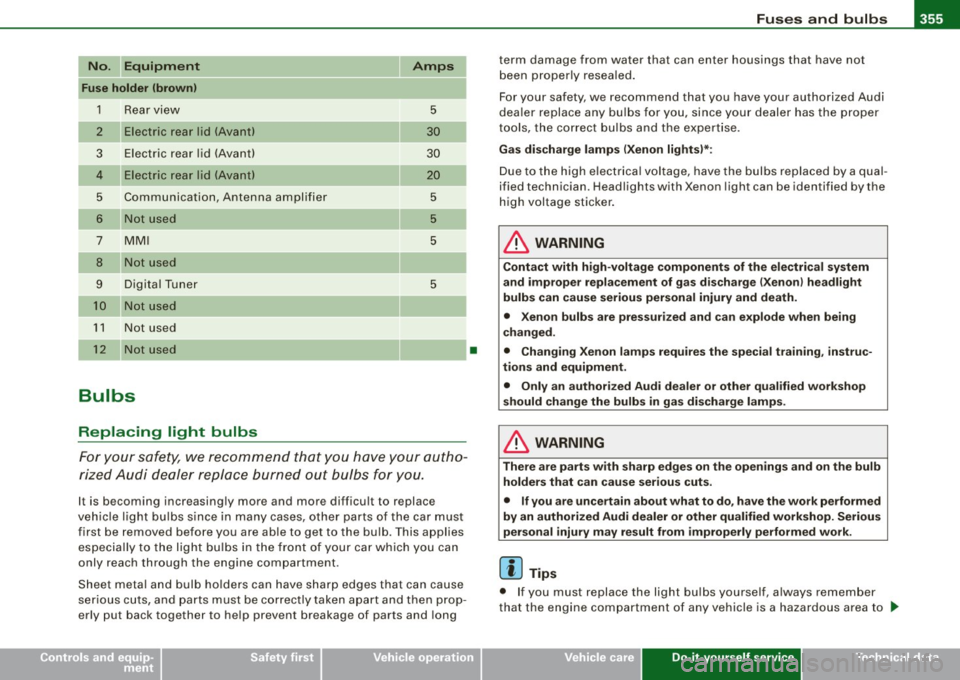
Fuses and bulbs -
----------------
•
No. Equipment
Fuse holder (brown)
1 R ear vi ew
2 Elect ric rea r lid (Ava nt)
3 Elect ric rea r lid (Avant)
4 Ele ctr ic rea r lid (Ava nt)
5 Communication, Antenna amplifier
6 N ot used
7 M MI
8 Not used
9 Digital Tuner
10 Not u sed
11 Not used
1 2 Not u sed
Bulbs
Replacing light bulbs
Amps
5
30
30
20
5
5
5
5
Fo r yo ur sa fe ty, we rec om mend t hat yo u have your a utho
rize d Audi d ea le r r ep la ce b urned out bul bs fo r you.
It is becoming increasing ly more and more difficult to replace
ve hicle light bu lbs s ince i n many cases, ot her parts of the car mus t
f irst be removed before you are able to get to the bu lb . T his applies
es pecia lly to the ligh t bu lb s in th e fro nt of y our ca r which you can
only reach through the engine compartment .
Sheet meta l and b ulb ho lders can have s harp edge s that can cause
ser ious c uts, and parts must be cor rectl y taken apart a nd t hen p ro p
erly put back together to he lp prevent breakage of parts and long
•
term damage from water that can enter housings that have not
b ee n properly resea led .
For your safety , we recommend that you have your authorized Audi
dea ler replace any bu lbs for you, since your dealer has the proper
t ools, the cor rect bulbs and the expertise.
Gas di scharge lamps (Xenon lights )*:
Due to the high e lectrica l voltage, have the bulbs replaced by a qual
ified technician . H eadlights with Xenon light can be identified by the
high voltage sticker .
& WARNING
Contact with high-voltage components of the ele ctrical system
and imprope r repla cement of gas discharge (Xenon) headlight
bulbs can cause serious personal injury and death.
• Xenon bulbs are pressurized and can explode when being
changed.
• Chang ing Xenon lamps requires the special training , instruc
tions and equipment .
• Only an authorized Audi dealer or other qualified workshop
s hould change the bulbs in ga s di scharge lamps.
& WARNING
The re are parts with sharp edges on the openings and on the bulb
holders that can cause serious cuts.
• If you are uncertain about what to do , have the work performed
by an authorized Audi dealer or other qualified workshop. Serious
per sonal injury may result from improperly performed work .
[ i ] Tips
• I f you must replace the light bu lbs yourself, a lways remember
that the engine compartment of any vehicle is a hazardous area to .,,
Do-it-yourself service